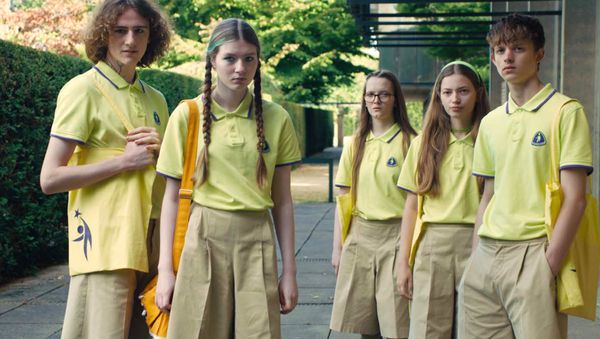 |
| Ms Novak’s (Mia Wasikowska) students Fred (Luke Barker), Ragna (Florence Baker), Helen (Gwen Currant), Elsa (Ksenia Devriendt), and Ben (Samuel D Anderson) in Jessica Hausner’s bewitching Club Zero |
In the second installment with Jessica Hausner on Club Zero (co-written with Geraldine Bajard) and scored by Markus Binder (European Film Award winner), starring Mia Wasikowska (as Conscious Eating instructor Ms Novak), we discussed her longtime collaborators, costume designer Tanja Hausner (recent work includes Frauke Finsterwalder’s Sisi & I, Ulrich Seidl’s Rimini and Sparta) and cinematographer Martin Gschlacht (Silver Bear winner in the 2024 Berlin Film Festival for Veronika Franz and Severin Fiala’s The Devil’s Bath, Des Teufels Bad) plus Sidse Babett Knudsen (Ms Dorset, the head mistress of an elite international boarding school) and Peter & The Wolf.
 |
| Jessica Hausner on using Peter & The Wolf in Club Zero: “It’s a very common fairytale and we found out that it’s really very well known …” Photo: Anne Katrin Titze |
The parents of the students are played by Elsa Zylberstein (Simone Veil in Olivier Dahan’s all-embracing portrait Simone: Woman Of The Century) Mathieu Demy (Delphine Deloget’s All to Play For, Julie Delpy’s upcoming Les Barbares), Camilla Rutherford (Paul Thomas Anderson’s Phantom Thread), Sam Hoare, Keeley Forsyth (Yorgos Lanthimos’s Poor Things), Lukas Turtur, Laoisha O'Callaghan, and Amanda Lawrence.
From Vienna, Jessica Hausner joined me on Zoom for an in-depth conversation on Club Zero.
Anne-Katrin Titze: Sidse Babette Knudsen is wonderful as the headmistress of the school. I love the scene when she has, I suppose, the fasting tea she got from Ms. Novak with milk and sugar and a cookie! She is counter-intuitive casting in a way, no?
Jessica Hausner: Yes, she has, of course as the headmistress a powerful position in that whole hierarchy in the film and at the same time that character seems to be blind and doesn’t at all notice what is actually going on in that school. We talked about that a lot, Sidse and me. How do you create that character who is truly trying to be a good headmistress and who at the same time doesn’t relate at all and doesn’t really understand what’s happening?
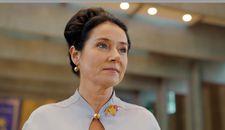 |
| Sidse Babett Knudsen as the head mistress Ms Dorset |
I think for us in that discussion it was important to say that of course for the headmistress it is important to please the parents. The parents who pay for an enormously expensive school are very powerful and it’s important for the headmistress that they don’t get the feeling that something is going on.
AKT: I want to talk about the costumes. Your sister [costume designer Tanja Hausner] has quite a fantastic range. From Ulrich Seidl’s Rimini, dressing the character of Richie Bravo, to the very beautiful costumes for [Frauke Finsterwalder’s] Sisi & I. Then there are your uniforms with the pale yellow shirts, the beige skorts, and the purple knee socks. No traditional school wear at all, somehow strangely timeless.
JH: Well, in the beginning of preparation of every film, I talk to my sister Tanja about the costumes. She reads the script and she is one of the very first people to give their opinion. Tanja is also the one who comes up with a lot of visual inspiration. She’s not digital yet, so she really goes and does print-outs, photocopies of images in books and newspapers. She comes with a hundred pages to me and then we put them on my table and we start to discuss the colours and the style of the lead character and any character that brings some ideas to us.
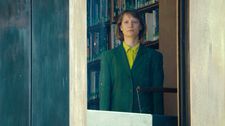 |
| Mia Wasikowska as Conscious Eating instructor Ms Novak |
And Tanja not only comes up with ideas about colour, but also style. So for Ms Novak we found that style of her wearing those male jackets and very properly closed polo shirts. It gives her that feeling as if she were also wearing a uniform, or an armor even. We thought of her going to war with her big jackets. Whereas the bright yellow of the school uniform, I think we thought about the colour of spring flowers. Like the collar of your shirt.
AKT: I wore it especially for you!
JH: Thank you, that’s very kind. There’s that spring flower …
AKT: Daffodils, like those behind me?
JH: Maybe, yeah. Yellow is definitely a flower colour. The flower, the delicacy of youth was also on our minds.
AKT: The flower motif also appears in the ballet Fred is in, Peter & the Wolf. There is a fairy tale again. Why did you choose Peter & the Wolf?
JH: It’s a very common fairytale and we found out that it’s really very well known and a little bit old fashioned. And it’s a little bit too childish for those children, which I like, because that was also the idea, to pronounce the fact how young those people are. Although they are tall and look like adults really they are still very young and very open-hearted.
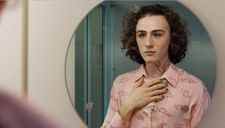 |
| Fred (Luke Barker) performs in Peter & The Wolf |
AKT: Did you see Suzie Templeton’s stop motion animation of Peter & the Wolf?
JH: I don’t think so.
AKT: It won the Oscar in 2008. It’s a beautiful short and she does the story without narration and all is told by the music and the expressions on the animals’ faces and bodies. It’s one of Wes Anderson’s favourite films.
JH: I’ll look it up!
AKT: It adds another layer to Fred’s personality when we see him dance. And as you say, it is a reminder that we are dealing with children who are so desperate to find something of meaning.
JH: And also the question of who is the wolf? This came up when talking to Mia Wasikowska about the role of Ms Novak. After some investigations and interviews we did, we decided that Ms Novak is actually really a believer. She’s not on purpose manipulating the children to something bad, but she has a good purpose. She really thinks and believes that it’s good what she’s offering to the children. So I liked that strange version of the wolf. She is the wolf, of course, she is the threat for the children, but the wolf is disguised in a very friendly and harmless personality.
 |
| Hunter College vending machines Photo: Anne Katrin Titze |
AKT: The wolf in polo shirts! I also noticed the colour blocking. That the colours she wears tend to cut her body in half. We don’t know much about her. But some of the wolfishness is in her smile on the tea carton.
JH: Yes, that’s true!
AKT: It’s funny to see that grin and the principal saying, you have a lovely smile there. The vending machines, Nibbles or Nibbli?
JH: Nibbli!
AKT: You invented these high-protein meat vending machines?
JH: Yes, the production design team invented it.
AKT: Very much again the reality of colleges, schools, those vending machines that have a lot of garbage in them. I liked the cafeteria scene where you show the five left-over ones from the conscious eating class cutting their food, pretending to eat their meal. It reminded me of so many movies, where - which can be quite annoying and distracting in cinema - we see the actors’ craft of fake chewing.
JH: I understand what you mean, yeah. Normally actors are not asked to really eat. On the other side, something that also happened during the shooting of Club Zero, some adult actors have never been asked to actually eat in front of the camera. Of course in that film, you couldn’t avoid it, because either you eat or you don’t eat, so I had to make that difference very clear.
 |
| Club Zero gathering |
AKT: On another note, was Jonathan Glazer inspired by your casting in Amour Fou? Is that why he cast Christian Friedel and Sandra Hüller in The Zone of Interest?
JH: I don’t know, but I was very happy to see both actors again in that film, Zone of Interest. I understand why he chose them, they are wonderful.
AKT: They are great together and the film is truly outstanding. I am not in Berlin, but am of course following what is going on. I see that your cinematographer Martin Gschlacht is there with Devil’s Bath. You worked with him on most of your films?
JH: On all of them!
AKT: Do you have a shortcut by now? He knows what you want?
JH: Yes, in a way. I think the way we work together has to do with the way that in my films the cinema language has a character of its own. So the DP Martin Gschlacht once told me that in most other films he is asked to follow the actors and the action as good as he can, and the opposite is the case in my films. Sometimes the camera is locked and doesn’t move and the actors come into the frame and go out of the frame and the camera doesn’t care.
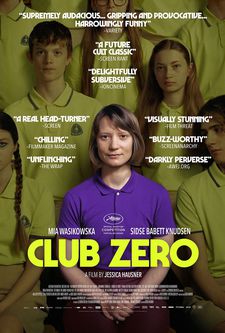 |
| Club Zero poster |
There is a different perspective that is being created in my films, which is very much about also showing a world that is not coherent. We don’t know everything. Some things happen off-frame, some things we missed, some things are sort of left out of the view. This is for me an interesting process to create those scenes and to find those images that invite the audience to ask themselves: what did I miss?
AKT: What exists outside the box - I noticed how you show a lot of ceiling in this film.
JH: Yes, and there is also a lot of, I think it’s called God’s Eye, the look from above down on the action, which is also about showing the fact that it’s totally a question of perspective. If you yourself are the person who believes in something crazy, you won’t find it crazy. But if you step aside and see yourself from outside, suddenly you would say, oh she’s crazy.
Read what Jessica Hausner had to say on food, fairy tales and parental fears, the Pied Piper of Hamelin, wanting to be seen, casting Elsa Zylberstein and Mathieu Demy as parents, and more.
Club Zero is in cinemas in the US.
Jessica Hausner’s Lovely Rita, Hotel, and Lourdes are available on the Film Movement Video on Demand platform.





















